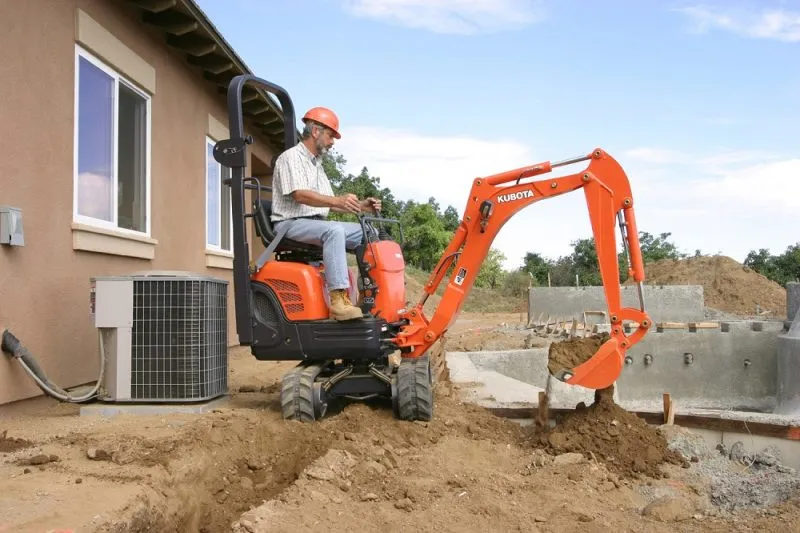A mini excavator is a compact, powerful machine designed for digging, trenching, lifting, and demolition in areas where larger equipment can’t fit. Whether you’re a contractor working on a small construction site or a homeowner planning a backyard project, mini excavators offer flexibility and precision. Their lightweight design and easy controls make them ideal for tight spaces, narrow access areas, and soft ground conditions.
In this blog, we’ll explain what is a mini excavator, how it works, and when it makes the most sense to use one. If you’re exploring equipment options, understanding this machine is a great place to start.
What Is a Mini Excavator?
A little counterpart of a regular excavator is called a mini excavator. It has a bucket at the end, a long arm, and an operator cabin. It runs on wheels or rubber tracks. The machine can rotate in a full circle, which helps in small areas.
They are frequently employed in spaces that are too small for giant excavators. These machines are popular for jobs that need precision and light digging.
How Does a Mini Excavator Work?
Mini excavators use hydraulic systems. This indicates that their movement is dependent on fluid pressure. Inside the cabin, the operator uses joysticks to control the machine.
Main Parts of a Mini Excavator:
- Cabin: Where the operator sits
- Boom: The long arm that extends from the machine
- Dipper: Connects the boom to the bucket
- Bucket: Used for digging and lifting
- Tracks or Wheels: Allow the machine to move
- Blade: Used for leveling ground (in some models)
The operator uses the controls to move the arms, bucket, and machine. The hydraulic system powers each movement. This makes the mini excavator smooth and easy to use.
What Jobs Are Mini Excavators Good For?
Mini excavators are ideal for a wide range of small to medium-sized tasks. Their compact size, easy handling, and powerful digging capabilities make them a smart choice for projects in tight or limited-access areas. Whether you’re working in a backyard or on a city site, these machines can handle many types of jobs.
1. Trenching
Mini excavators are often used to dig narrow trenches for cables, pipes, or drainage systems. Their precision allows for clean, straight cuts with minimal disruption to the surrounding area.
2. Landscaping
From digging holes for trees to leveling garden beds, mini excavators are helpful for various landscaping tasks. They are perfect for backyard renovations and soft landscaping work.
3. Utility Installation
Plumbers and electricians use mini excavators to access underground lines. These machines can dig around existing structures without causing damage.
4. Light Demolition
With the right attachment, mini excavators can break down small sheds, walls, pavements, and patios. This is helpful for demolition tasks in homes and small businesses.
5. Site Clearing
Mini excavators are used to remove debris, old materials, tree stumps, and rocks from a job site. This prepares the area for the next stage of work.
6. Driveway and Footpath Repairs
They can dig up damaged concrete or asphalt surfaces before repair. Their compact size makes them ideal for locations with plenty of foot activity.
7. Pool and Pond Excavation
Backyard ponds, pools, and other water features are frequently shaped with mini excavators. Their agility is useful in confined garden areas.
Road and Pavement Repairs
Mini excavators can remove damaged concrete or asphalt in small road repair jobs.
These machines are quiet, easy to control, and less likely to damage nearby structures. Their small size helps them move easily through gates, alleys, and narrow paths.
Mini Excavator vs Standard Excavator
Both machines serve similar purposes, but they are built for different types of work.
| Feature | Mini Excavator | Standard Excavator |
| Size | 1–5 tonnes | 6 tonnes and above |
| Space Needed | Small, tight areas | Large, open job sites |
| Digging Depth | Up to 3 meters | More than 6 meters |
| Movement | Easy to move | Needs larger trailers |
| Fuel Use | Less fuel | More fuel |
| Control | Simple | More complex |
Mini excavators are easier to operate. They are better for short-term and light jobs. Standard excavators are built for deeper and heavier digging.
When Should You Use a Mini Excavator?
A mini excavator is the right tool for many small to medium jobs. You should use one when:
- Space is limited and a big machine cannot fit
- You need to dig a trench or move soil in a yard
- A task requires light demolition
- The job is short-term and moving a large machine is not worth the effort
- You want to protect nearby surfaces from heavy equipment damage
Mini excavators are also popular with first-time users. Their controls are simple and the machine is easy to learn. With the right planning, one machine can complete several tasks in one project.
If you’re looking to rent equipment for such jobs, DMAG Rental Equipment LLC offers compact and reliable mini excavator options tailored for Dubai’s construction needs.
FAQs
What size is a mini excavator?
The majority of small excavators weigh one to five tons.
Can a mini excavator dig deep holes?
Yes. They can dig up to around 3 meters deep depending on the model.
Are mini excavators easy to use?
Yes. The controls are simple, and the machine is easy to learn for beginners.
Can I use a mini excavator in a backyard?
Yes. These machines are designed to fit in tight areas like backyards.
What kind of tasks are best suited for a tiny excavator?
Utility work, light demolition, landscaping, and trenching are all excellent uses for mini excavators.

